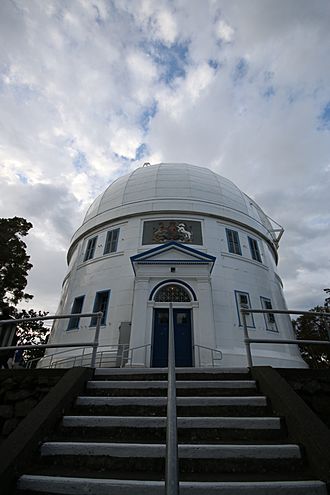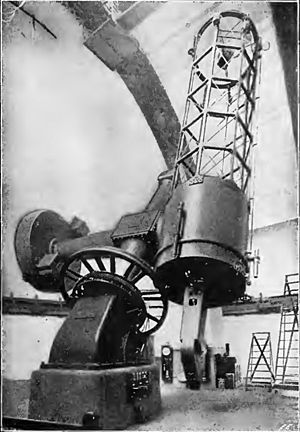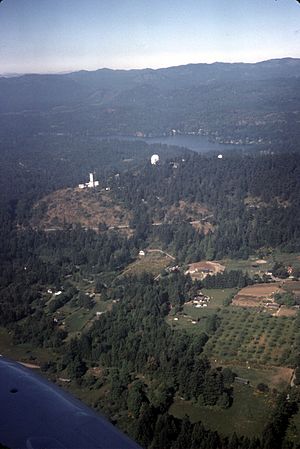Dominion Astrophysical Observatory facts for kids
Quick facts for kids Dominion Astrophysical Observatory |
|
|---|---|
 |
|
| Alternative names | Observatoire fédéral d'astrophysique |
| General information | |
| Coordinates | 48°31′11″N 123°25′06″W / 48.51980°N 123.41833°W |
| Current tenants | National Research Council |
| Opened | 1918 |
| Design and construction | |
| Architect | Edgar Lewis Horwood |
| Architecture firm | Dominion Architect of Canada |
| Official name: Dominion Astrophysical Observatory National Historic Site of Canada | |
| Designated: | 2008 |
The Dominion Astrophysical Observatory (DAO) is a famous place where scientists study space. It is located on Observatory Hill in Saanich, British Columbia, Canada. The Canadian government finished building it in 1918. Edgar Lewis Horwood was the main architect for the building.
The most important tool here is the Plaskett telescope. It has a huge mirror, about 72 inches (1.8 meters) wide. John S. Plaskett first suggested and designed this telescope in 1910. He led the observatory until 1935.
The observatory is a national historic site of Canada. This means it's a very important place in Canadian history. Many big discoveries about our home galaxy, the Milky Way, were made here. Until the 1960s, it was one of the world's top places for astrophysical research.
Contents
Exploring the Universe at DAO
The Centre of the Universe is a special place for visitors at the observatory. It's right across the parking lot from the big telescope. This center helps people learn about space and the work done at the observatory.
The center often hosts free public "star parties" on Saturday nights. These events are also supported by the Royal Astronomical Society of Canada, Victoria Centre (RASC). You can look through telescopes, both during the day to see the sun and at night to see stars. There are also talks, presentations, and cool exhibits. These events have been happening since the observatory first opened, only stopping for World War II and the COVID Pandemic.
Inside the center, you'll find interactive displays about astronomy. You can see the original mirror of the telescope, made in 1914. There's also a small model of the telescope dome, built in 1915. Tours of the main telescope start from here. The center even has a 25-seat planetarium that looks like the sun! It uses special software to show the night sky, star movements, and even full-dome movies.
The Centre of the Universe first opened in 2002. It closed for a short time in 2013 due to money issues. But it reopened in 2014 thanks to a group of people who wanted to save it. This group, called the Friends of the Dominion Astrophysical Observatory Society (FDAO), now runs the public programs. They offer more star parties, tours, and events for everyone to enjoy.
Building the Giant Telescope
The building that holds the telescope was built by McAlpine-Robertson Company. The dome, which protects the telescope, was made by Warner & Swasey Company. Both the building and the dome have double walls for protection.
The huge glass mirror is about 73 inches (1.85 meters) wide and 12 inches (0.3 meters) thick. It weighs around 4,340 pounds (1,968 kg)! The Saint-Gobain company in Belgium made the mirror. It was shipped just one week before World War I began.
The mirror was then polished in the United States. This process took longer than expected. The mirror had to be polished twice more because of a scratch and a flaw. This added two years to the telescope's completion time, pushing it to 1918. Finally, the finished mirror traveled by train to Victoria. Horses and wagons then pulled it up Little Saanich Mountain.
How the Telescope is Used
The Plaskett telescope uses special equipment to study light from space. A spectrograph helps scientists break down starlight into its different colors. This tells them what stars are made of and how they are moving. An imaging charge-coupled device (CCD), like a digital camera sensor, also captures images.
In 1962, another telescope was added to the observatory. This one has a 48-inch (1.2-meter) mirror. It was made in England. This telescope also uses a large spectrograph to study light in great detail.
Since 1995, the DAO has been the main office for the NRC Herzberg Institute of Astrophysics. This group runs several Canadian telescopes, both optical (for visible light) and radio (for radio waves). They work with other big telescopes around the world, like the Canada-France-Hawaii Telescope. These telescopes are always busy, helping scientists learn more about the universe.
As of October 2022, Dr. James Di Francesco was the Director of the Dominion Astrophysical Observatory.
A World-Class Telescope
The Plaskett telescope was meant to be the biggest in the world. However, there were delays in its construction. It saw its "first light" (meaning it was used for the first time) on May 6, 1918. This was six months after the 100-inch Hooker telescope at Mount Wilson Observatory in the United States. Even so, the Hooker telescope also faced delays, especially from World War I.
At that time, most observatories still used older telescopes with much smaller mirrors. The Plaskett telescope was a huge step forward. It was also bigger than the 72-inch Leviathan of Parsonstown, an older metal mirror telescope built in 1845.
The Plaskett telescope was the second-largest in the world until 1935. That's when the 74-inch reflector at the David Dunlap Observatory (also in Canada) opened.
Here's how the top two telescopes compared in 1918:
| Number | Name / Observatory |
Image | Aperture | Altitude | First Light |
Special advocate |
|---|---|---|---|---|---|---|
| 1 | Hooker Telescope Mount Wilson Obs. |
100 in 2.54 m |
1,742 m 5,715 ft |
1917 | George Ellery Hale Andrew Carnegie |
|
| 2 | Plaskett telescope Dominion Astrophysical Obs. |
72 in 1.83 m |
230 m 750 ft |
1918 | John S. Plaskett |
The next largest telescopes were the 60-inch ones at Harvard College Observatory and Mount Wilson.
See also
 In Spanish: Observatorio Astrofísico Dominion para niños
In Spanish: Observatorio Astrofísico Dominion para niños
- NRC Herzberg Institute of Astrophysics
- Dominion Radio Astrophysical Observatory
- List of largest optical reflecting telescopes
- List of largest optical telescopes in the 20th century



